Restrooms as an element of the public realm
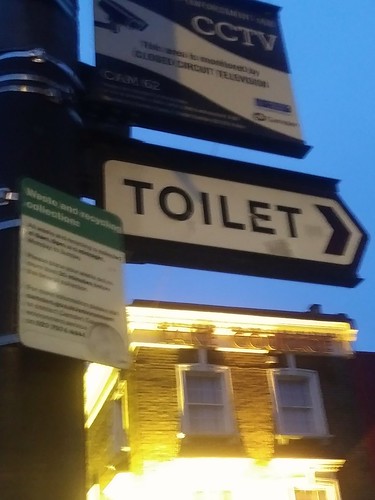 Toilet wayfinding sign, Camden Borough of London
Toilet wayfinding sign, Camden Borough of LondonBack from the UK. Didn't really have access to a computer. Wouldn't have had time to write anyway. Didn't see half of what I was hoping to see, because "merely" walking around is so valuable.
But the very first thing that stuck out for me was the high quality of the restrooms, which they very directly call "Toilets," and the provision of them in public places.
Sure, restrooms in train stations and in certain public districts like Covent Garden can only be used if you pay a fee of 30 pence in the train stations and 50 pence in Covent Garden. And those restrooms aren't necessarily state of the art.
But they are way better than the gnarly facilities in say, Union Station in DC.
The restrooms at museums, stores like Selfridges, Heathrow Airport, etc.--Selfridges especially--were exquisite. Restrooms at National Airport are decent enough, way better than at Union Station. Granted the restrooms at Union Station are also used by the homeless, which probably puts much more stress on the equipment.
Yes, in Washington, DC, restrooms at hotels etc. are decent. The restrooms at National Gallery are decent. I really like the restrooms at National Building Museum, which are "old-fashioned." But they are the exception.
Restroom at V&A Museum, London
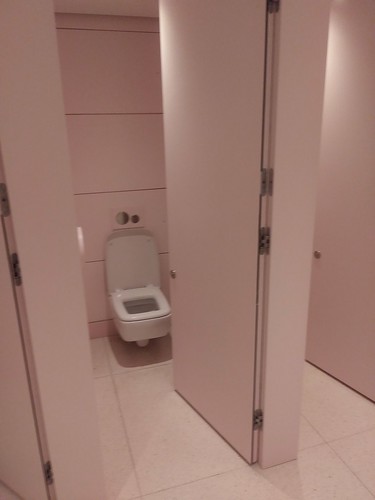
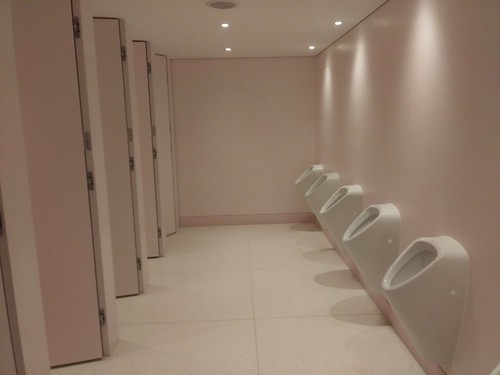
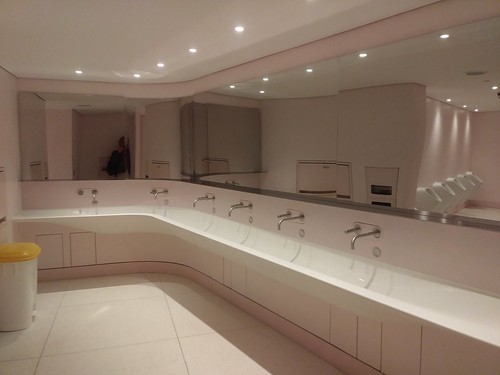
Public toilet at Covent Garden, London. Note the tiled art showing historic views of St. Paul's Church.
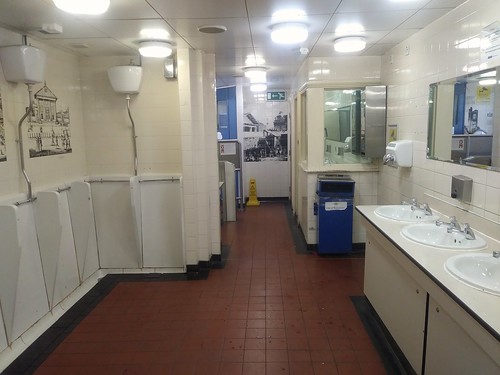
Now it's easy for me to overgeneralize, but "globalizing" is my nature, but I would say that the difference is a recognition that the quality of where you go to the bathroom matters, and that when you're in public it matters just as much as in private, and that the idea of the provision of a public realm of quality extends to restrooms.
In the US, what has happened is that because of the hindrance of having to pay for a restroom, there may be laws about not charging. What's happened as a result is that most local governments no longer provide restrooms in public spaces ("Why does D.C. have so few public restrooms?," Washington Post).
(When I was a child, say at the Hudson's Department Store in Downtown Detroit, to access a restroom stall there was a coin-based entry device, and it cost 5¢ That was for the stall, it was probably free to use the urinal.)
Restrooms are accessible in businesses, but like the recent Starbucks incident in Philadelphia ("Starbucks tells employees: Let anyone use the restroom," Associated Press), you're supposed to be a customer--buying something--in order to have access. And many firms don't invest enough money in maintenance to keep the facilities high quality. Plus some people are pigs ("It takes two (parties) to keep a restaurant bathroom in order," Washington Post).
Of course there are plenty of exceptions. Restrooms at Hank's Cocktail Bar in Petworth or The Coupe in Columbia Heights are nicely done. And the fancier places these days understand the value of investing in the restroom as part of a total focus on the experience of the place (and brand). And I've been thinking lately about how cool restaurants could specifically design restrooms as art installations--immersive experiences.
But it is also an element of destination management, and most places don't have well enough development "visitor management" protocols in place to even consider this issue in a considered manner.
High tourism cities especially should be focused on managing as many aspects of the visitor experience as possible. But commercial district management and revitalization organizations should be equally concerned as it relates to this element too.
-- "Town-City branding or 'We are all destination managers now," February, 2005
About four years later, in plans I wrote for Cambridge Maryland and Brunswick Georgia I extended this idea along the lines of brand management of a city/county, writing in those plans:
Just as the study team believe
s that “we are all destination managers now,” elected and appointed officials in particular and in association with other community stakeholders serve as a community’s “brand managers”—whether or not they choose to think of their roles in this manner.That means "public facilities" too, like toilets/restrooms.
That means that decision-making on land use and zoning, business issues, infrastructure development (roads, sewers, water, utilities, transit), technology (broadband Internet, etc.) and quality of place factors (arts, culture, historic preservation and heritage, education, public schools and libraries, etc.) must be consistent and focused on making the right decisions, the decisions that collectively achieve and support the realization of the community’s desired vision and positioning.
==========
This post was sponsored by the donors--anonymous and named, to the GoFundMe account associated with my recent trip to Liverpool and London, which was triggered by my receiving a free registration to the International Place Branding Event one-day conference in Liverpool. Their support is gratefully acknowledged in making this and many other posts possible.
(Donations are still appreciated.)
Labels: branding-identity, destination management, provision of public services, public realm framework, restrooms, urban design/placemaking, visitor services



2 Comments:
Keeping a restroom maintained is undoubtedly a chore for businesses. I fear the Starbucks incident will backfire. I'd pay for decent reliably clean and safe restrooms, which some would find offensive, but as we know is not unheard of outside the US. I too remember coin operated stalls in stores, and paying for facilities in Europe. I remember shelling out small change for meager rations of TP in recently post-communist DDR, CZ and H circa fall 1990.
https://www.bostonglobe.com/2019/11/14/opinion/though-ubiquitous-toilets-arent-available-everyone-that-should-change/
Post a Comment
<< Home